The pictures here show the major stages in the construction of a
Zuckermann Italian III harpsichord kit. This was built in 2006, but
adjustment of voicing goes on to this day. This kit is no longer
available I believe and is not for the faint-of-heart. It needs a lot
of precision in woodwork to get the case jointing and fitting of the
moldings right. There is no chance of hiding errors under a layer of
paint.
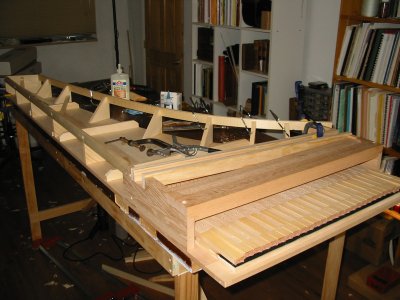
Here we are,
fixing the top framing of the bent side to the knees which are screwed
to to the bottom.. The "horse" or wrestplank assembly is complete and
the keyboard has been test fitted on its frame and laid in place. The
bottom of the case had shrunk considerably in storage and was narrower
than the horse; it was built out in the treble end with a thin strip of
suitable wood.
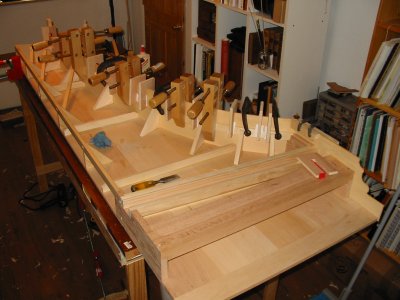 Definitely the most nerve-wracking operation - glueing in the bentside. You have
about 10 minutes to get the bentside clamped and nailed in place, when
it is coated with slippery glue. Meticulous preparation is needed to
make sure it fits exactly between the cheek and the tail, which are
glued in place first. The bentside needs to snap in between those parts
with essentially zero tolerance. Every clamp in the house was
commandeered - the Zuckermann supplied clamps did not seem quite up to
the task by themselves.
Definitely the most nerve-wracking operation - glueing in the bentside. You have
about 10 minutes to get the bentside clamped and nailed in place, when
it is coated with slippery glue. Meticulous preparation is needed to
make sure it fits exactly between the cheek and the tail, which are
glued in place first. The bentside needs to snap in between those parts
with essentially zero tolerance. Every clamp in the house was
commandeered - the Zuckermann supplied clamps did not seem quite up to
the task by themselves.
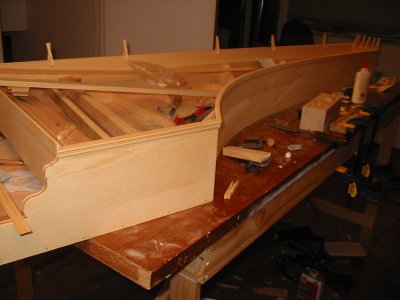 Glueing on moldings - of which there are several miles, with lots of exposed
miter joints to get dead right. Note the use of high-tech clamping
technology.
Glueing on moldings - of which there are several miles, with lots of exposed
miter joints to get dead right. Note the use of high-tech clamping
technology.
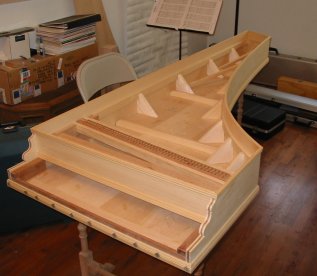 Here, the case is close to complete and has been tidied up. (It would be a
mistake to leave bits of loose wood or tools inside when fixing in the
soundboard). Note the knees, and battens and struts which form the framing in this model of
harpsichord. The nameboard has been trial fitted, as have the registers
for the jacks.
Here, the case is close to complete and has been tidied up. (It would be a
mistake to leave bits of loose wood or tools inside when fixing in the
soundboard). Note the knees, and battens and struts which form the framing in this model of
harpsichord. The nameboard has been trial fitted, as have the registers
for the jacks.
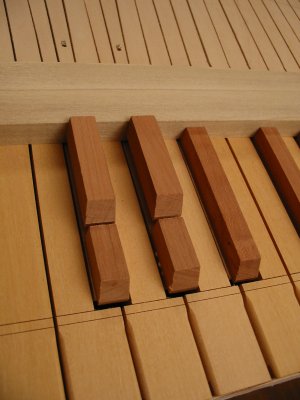 Keys in their rough state. There is quite a lot of repetitive sanding to make the
keys agreeable to the touch.
This picture shows the short-octave arrangement in the bass where the
back of the lowest chromatic key plays F# and the front plays D. G# and
E share the next chromatic key. This was done to save space on old Italian harpsichords.
Keys in their rough state. There is quite a lot of repetitive sanding to make the
keys agreeable to the touch.
This picture shows the short-octave arrangement in the bass where the
back of the lowest chromatic key plays F# and the front plays D. G# and
E share the next chromatic key. This was done to save space on old Italian harpsichords.
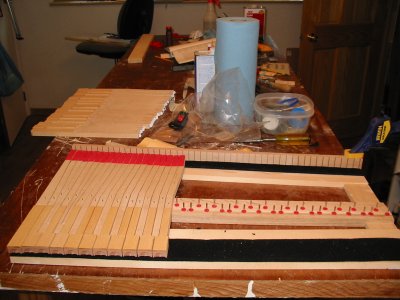 Laying the keys into the keyframe and regulating their spacing and position. The
keys sit on felt bushings and their travel is limited by strips of wool
cloth for silent action.
Laying the keys into the keyframe and regulating their spacing and position. The
keys sit on felt bushings and their travel is limited by strips of wool
cloth for silent action.
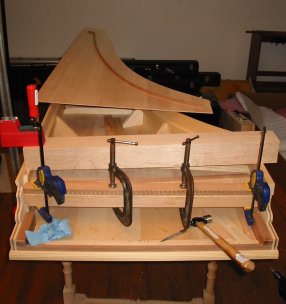 Glueing in the soundboards. There is a little soundboard over the wrest-plank to
add resonance, which is being glued here. The main soundboard has its
bridges glued in place and
is sitting on the case waiting for a day of appropriate humidity to fix
it in place in the case.
Glueing in the soundboards. There is a little soundboard over the wrest-plank to
add resonance, which is being glued here. The main soundboard has its
bridges glued in place and
is sitting on the case waiting for a day of appropriate humidity to fix
it in place in the case.
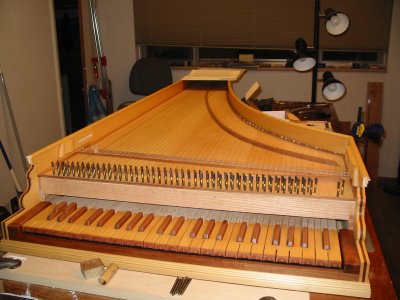 Stringing here is almost complete. The instrument is all strung in brass. The
keyboard is all finished and installed.
The nameboard has been removed out of harms way for stringing. The case
by this time has been varnished bringing out the fine yellow color of
the cedar wood.
Stringing here is almost complete. The instrument is all strung in brass. The
keyboard is all finished and installed.
The nameboard has been removed out of harms way for stringing. The case
by this time has been varnished bringing out the fine yellow color of
the cedar wood.
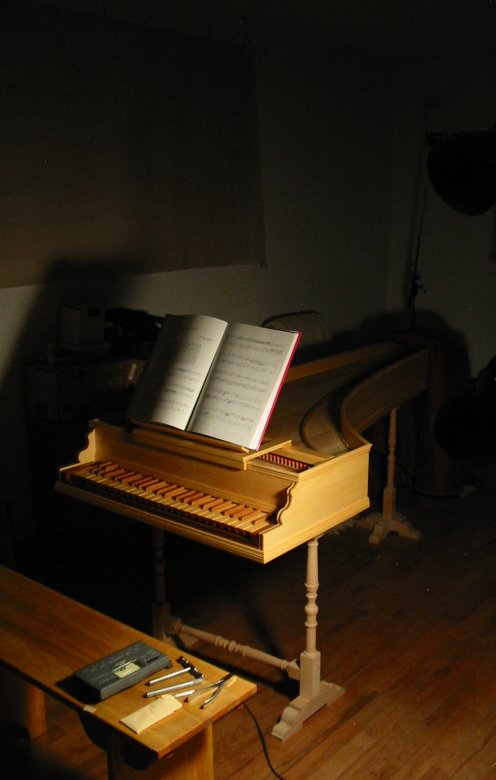
Here is a picture of the final result